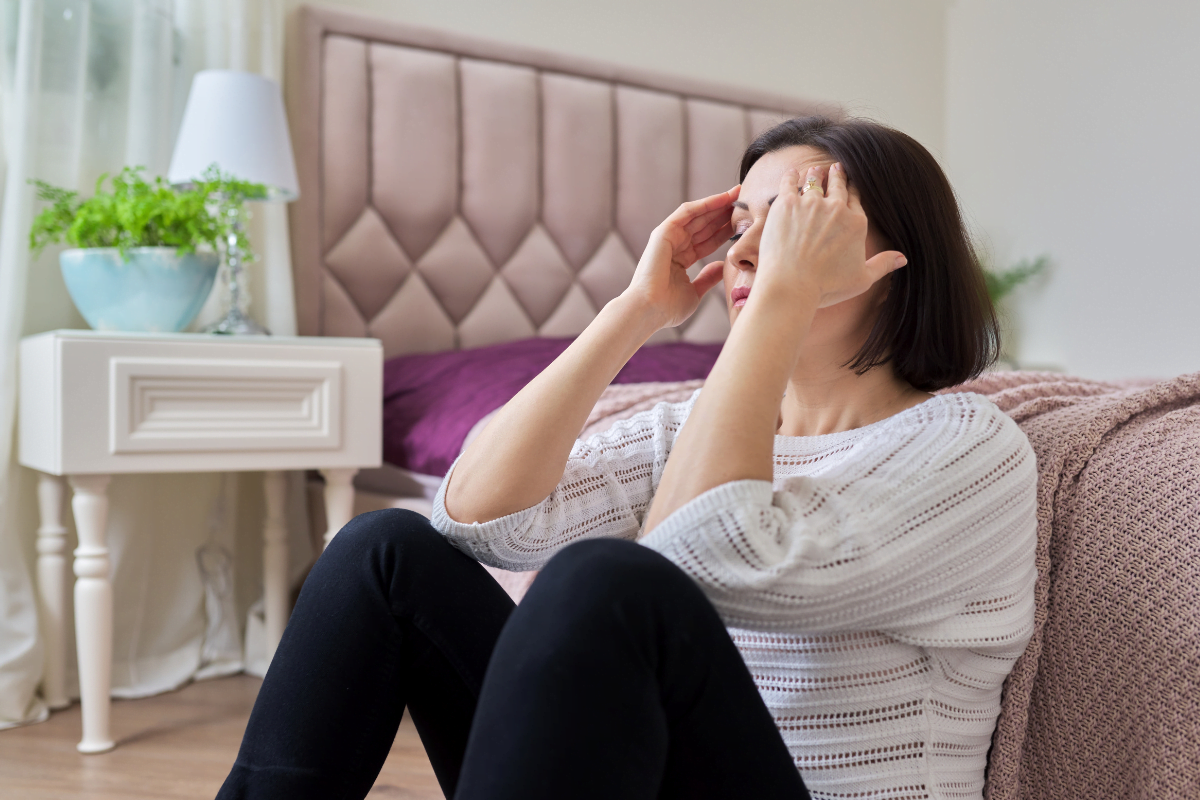Migraines and menstruation are two common yet often debilitating experiences many women face. As a woman, understanding the relationship between the menstrual cycle and migraines can provide helpful insights into managing these painful episodes more effectively. This article explores the connection between menstruation and migraines, the effect of menopause on headaches, and the potential impact of birth control on headaches.
The Menstrual Cycle and Migraines
Hormonal changes can heavily influence the onset and severity of migraines. Hence, there is a complex relationship between the menstrual cycle and migraines. Here are some explanations for this connection and its common symptoms among women:
Hormonal Fluctuations
The primary link between menstruation and migraines lies in hormonal fluctuations. Estrogen and progesterone levels significantly influence the frequency and severity of migraines. Just before menstruation, estrogen levels drop, triggering migraines in many women. This condition, known as menstrual migraine, typically occurs two days before and three days after the onset of menstruation.
Symptoms and Triggers
Menstrual migraines often present with more severe symptoms compared to other types of migraines.
These can include:
- throbbing pain
- nausea
- vomiting
- heightened sensitivity to light and sound
Common triggers for menstrual migraines include:
- stress
- lack of sleep
- certain foods
Managing Menstrual Migraines
Managing menstrual migraines can be a challenging task, but with the right strategies, it’s possible to reduce their impact on your daily life. Here are some ways to take control:
Preventive Measures
For people experiencing menstrual migraines, various strategies can help prevent them. These include sticking to a consistent sleep routine, effectively managing stress, and steering clear of known dietary triggers. It’s also beneficial to keep a migraine diary to monitor patterns and triggers, which can assist in effectively managing the condition.
Medical Treatments
Medical treatments for menstrual migraines aim to reduce the frequency, severity, and duration of headaches associated with the menstrual cycle. The primary options include nonsteroidal anti-inflammatory drugs (NSAIDs), triptans, and hormonal therapies.
NSAIDs such as ibuprofen and naproxen are often used to relieve the pain and inflammation associated with menstrual migraines. These medications are most effective when taken at the onset of migraine symptoms or as a preventive measure a few days before the expected start of menstruation.
Triptans belong to a class of medications that are specifically designed to treat migraines. These drugs, including sumatriptan and rizatriptan, work by targeting serotonin receptors to reduce inflammation and constrict blood vessels in the brain, effectively alleviating migraine symptoms. Triptans are typically used when NSAIDs are insufficient to control the pain.
Hormonal therapies can help stabilize hormonal fluctuations that trigger menstrual migraines. Options include oral contraceptives, estrogen patches, or hormonal supplements. Continuous or extended-cycle birth control pills can reduce the frequency of menstrual migraines by minimizing the hormone-free interval. For some women, estrogen patches applied during the menstrual cycle can help maintain stable estrogen levels and prevent migraine onset.
Headaches and Menopause
A woman’s transition into menopause can influence migraine patterns. Hormonal changes during this stage may lead to an increase or decrease in migraine frequency, providing a deeper understanding of this phase and its potential impact on women’s health.
Hormonal Changes During Menopause
The onset of menopause brings about major hormonal changes in a woman’s body, which can have an impact on headache patterns. Decreasing levels of estrogen during menopause can result in a higher occurrence and severity of headaches for many women.
Types of Headaches
Postmenopausal women may experience various types of headaches, including tension headaches and migraines. While some women find relief from migraines after menopause, others may notice an increase in headache occurrences.
Management Strategies for Menopausal Headaches
Dealing with headaches during menopause requires a mix of lifestyle adjustments and medical interventions. Regular exercise, a healthy diet, and stress-relief methods can help ease headache symptoms. Hormone replacement therapy (HRT) might be an option for some women, but it’s important to have a detailed discussion with a healthcare professional because of the potential risks involved.
Contraceptive-Induced Headaches
Using hormonal contraceptives like birth control pills, patches, and intrauterine devices (IUDs) may impact headache occurrences. The synthetic hormones present in these contraceptives can lead to hormonal fluctuations, potentially resulting in headaches for some individuals.
For women experiencing headaches due to hormonal contraceptives, several management strategies are available. Switching to a different contraceptive method, such as a non-hormonal IUD or barrier method, can alleviate headaches. Additionally, low-dose hormonal contraceptives may reduce the severity of headache symptoms.
Takeaways
It’s important to recognize the link between menstruation, menopause, and headaches for better management and treatment. Hormonal changes significantly impact the frequency and intensity of migraines and headaches in women. Identifying triggers and using preventive strategies can help women effectively manage headache symptoms and enhance their overall well-being.
When it comes to managing headaches related to menstruation, menopause, or contraceptives, seeking guidance from healthcare professionals is crucial for identifying the best treatment and coping approaches.
Frequently Asked Questions (FAQs)
When does progesterone drop before a period?
Typically, progesterone levels decrease around 10 to 14 days after ovulation if pregnancy hasn’t taken place. When this happens, along with estrogen, it can trigger the uterine lining to shed, which results in menstruation. The drop in progesterone usually starts in the luteal phase, about a week before the period, which can lead to premenstrual symptoms.
Can birth control cause headaches?
Yes, birth control can cause headaches in some individuals. Hormonal fluctuations caused by the estrogen and progestin in birth control pills can lead to headaches or migraines, particularly during the placebo week when hormone levels drop.
When do ovulation headaches occur?
Ovulation headaches typically occur around the time of ovulation, which is usually midway through the menstrual cycle, about 14 days before the start of the next period. These headaches are thought to be triggered by the rapid changes in hormone levels, particularly the surge in estrogen and luteinizing hormone that occurs just before the ovary releases an egg.
Can birth control cause migraines?
Yes, birth control can cause migraines, especially in individuals who are prone to them. Birth control pills can affect the frequency and severity of migraines. Estrogen-containing birth control pills, in particular, can be a trigger for migraines due to fluctuations in hormone levels, especially during the hormone-free interval.

